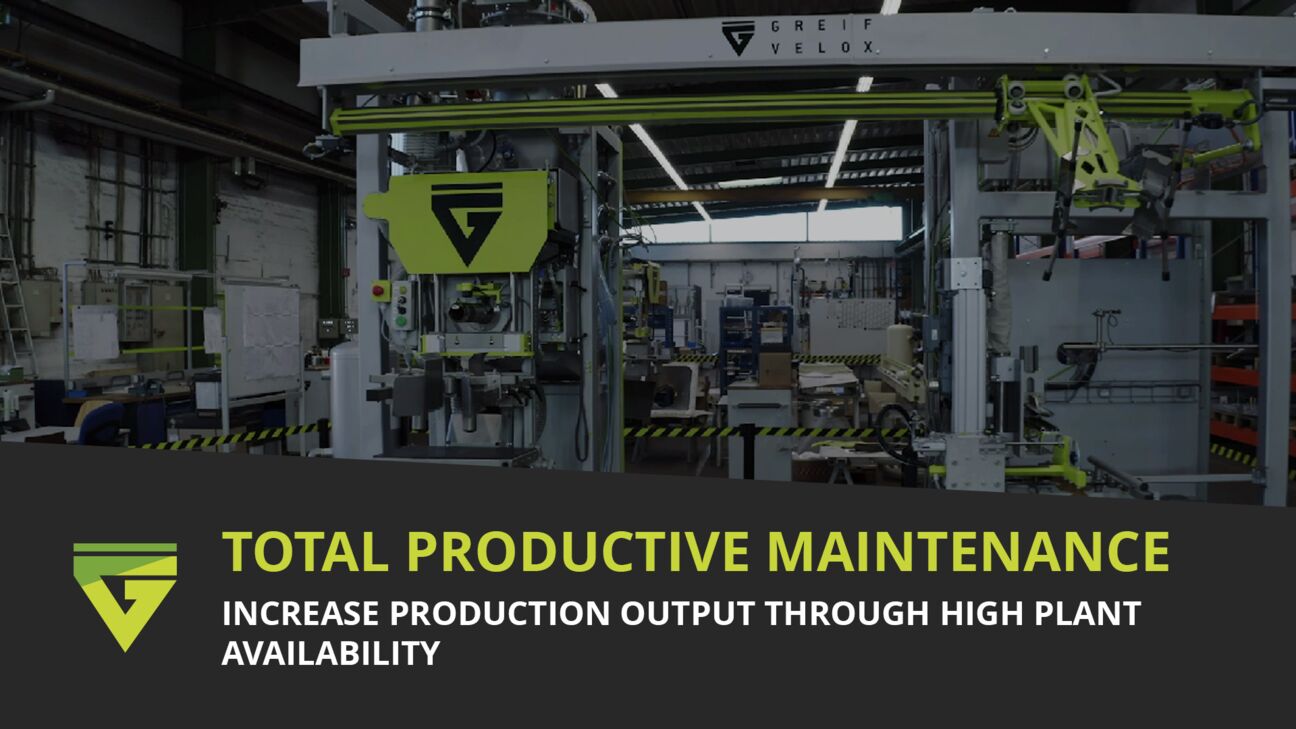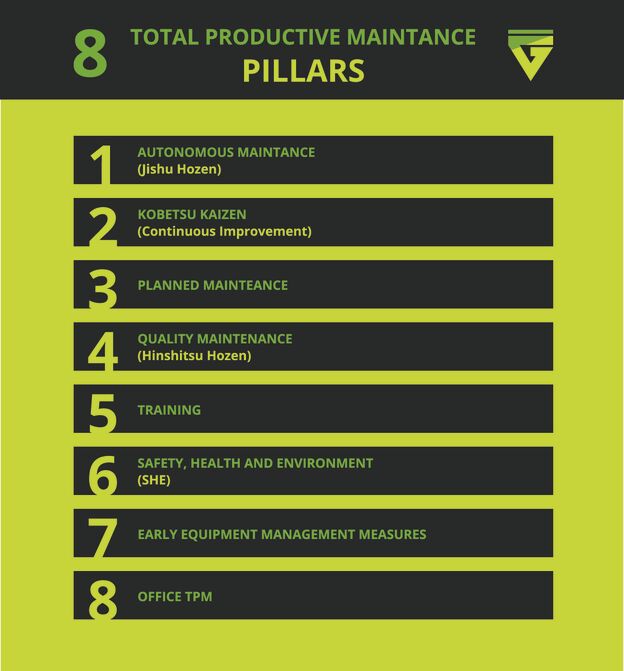Total Productive Maintenance (TPM): Increase production output through high plant availability
Total Productive Maintenance (TPM) is a method of Lean Production that involves all employees in maintenance tasks to maximize Overall Equipment Effectiveness (OEE) and minimize downtime. This sustainably enhances the production capacity of a company.
Originating in the 1950s in Japan, TPM combines preventive maintenance and continuous improvement.
The eight pillars of TPM aim to eliminate production losses, ensure quality, and enhance safety.
In Industry 4.0, TPM is supported by IoT and Big Data to utilize real-time data for predictive maintenance.
What is Total Productive Maintenance (TPM)?
Total Productive Maintenance (TPM) is a Lean method in manufacturing operations aimed at maximizing equipment availability and ultimately Overall Equipment Effectiveness (OEE).
To this end, TPM integrates maintenance tasks directly into the production process and actively involves all employees, from operational workers to management.
As a component of Lean Manufacturing, TPM aims to eliminate downtime, inefficient operational processes, and quality losses.
From a holistic business perspective, TPM plays a central role as a principle in Lean Management, as it seeks to minimize waste and optimize the value-adding process through continuous improvement and maintenance of production equipment.
How Did TPM Emerge?
The historical roots of Total Productive Maintenance (TPM) lie in the 1950s in Japan. Its origin traces back to the preventive maintenance concept inspired by Dr. W. Edwards Deming and his "Plan-Do-Check-Act" philosophy from the USA. Key impulses for the development of TPM came from Nippondenso, a supplier to Toyota. In the 1960s, Nippondenso implemented preventive maintenance programs to improve the reliability of machinery in manufacturing.
Seiichi Nakajima, regarded as the founder of TPM, expanded the concept in the early 1970s by combining preventive and autonomous maintenance measures. Operators were involved in simple maintenance tasks to quickly respond to problems and reduce downtime. This led to a significant improvement in efficiency, as operators contributed directly to maintenance, alleviating the burden on maintenance personnel. In 1971, TPM was officially recognized as a method by the Japan Institute of Plant Maintenance (JIPM).
What Are the 8 Pillars of TPM?
The 8 pillars of TPM are essential for the successful implementation of this maintenance strategy. Each pillar is aimed at the specific optimization of equipment availability and production performance.
The 8 Pillars of Total Productive Maintenance (TPM) are:
- Autonomous Maintenance (Jishu Hozen)
Machine operators take on simple maintenance tasks such as cleaning, inspection, and lubrication on their own responsibility. This relieves maintenance personnel and increases machine availability. - Kobetsu Kaizen (Continuous Improvement)
Systematic elimination of losses and inefficiencies in the production process. The goal is to gradually increase efficiency and minimize production losses. - Planned Maintenance
Targeted maintenance planning to prevent machine downtime. This increases the reliability of the equipment and reduces unforeseen failures. - Quality Maintenance (Hinshitsu Hozen)
Ensuring error-free production through early identification and elimination of quality problems in machines. This minimizes production scrap. - Training
Continuous qualification of employees to ensure they possess the necessary skills to perform maintenance tasks and recognize problems. - Safety, Health, and Environment (SHE)
Creating a safe working environment and preventing accidents. The goal is to protect employees and minimize negative environmental impacts. - Early Equipment Management Measures
Maintenance requirements are considered in the development phase of new equipment to ensure long-term reliability. - Office TPM
Applying TPM principles to administrative processes to optimize office workflows and reduce administrative losses.
Autonomous Maintenance (Jishu Hozen)
Autonomous Maintenance (Jishu Hozen) is a central pillar of TPM aimed at empowering machine operators to independently perform simple maintenance tasks such as cleaning, inspection, and lubrication.
This fosters a deeper understanding of the machines to stabilize their condition and minimize downtime. Maintenance specialists can then focus on more complex tasks, such as predictive maintenance and machine improvements.
In practical terms, autonomous maintenance aims to enable machine operators to detect deviations early and directly address minor defects. Through these measures, approximately 75% of potential machine failures can be prevented.
The seven steps of autonomous maintenance include:
- Employee Preparation
- Initial Cleaning of the Machines
- Implementation of Countermeasures
- Establishment of Preliminary Jishu Hozen Standards
- General Inspection
- Autonomous Inspection
- Standardization and Sustainable Management
Kobetsu Kaizen (Continuous Improvement)
Kobetsu Kaizen (also known as “continuous improvement”) is one of the central pillars of TPM, focusing on achieving gradual and continuous improvements in production.
The Japanese term “Kaizen” consists of “Kai” (change) and “Zen” (for the better) and describes a process of systematic optimization. In production processes, losses and inefficiencies are to be identified and eliminated to increase equipment availability and productivity.
Through Kaizen, small, incremental improvements are continuously made, leading to significant performance enhancements over time. This includes reducing cycle times, decreasing inventory, and eliminating sources of error. The goal is to increase productivity, improve machine flexibility, and maximize throughput.
Planned maintenance
Planned maintenance is a key pillar of TPM aimed at achieving continuous and uninterrupted equipment availability.
By implementing preventive measures, maintenance is proactively planned and carried out before failures occur. This increases reliability and extends the lifespan of the equipment.
In contrast to reactive maintenance, which intervenes only after a problem arises, planned maintenance reduces unplanned downtimes and failures.
Here are the 6 steps to implement planned maintenance:
- Assessment of equipment condition and recording the current state
- Restoration and improvement of the equipment to prevent wear
- Establishment of an information management system to monitor maintenance data
- Creation of a periodic maintenance system that is conducted regularly
- Development of a predictive maintenance system based on data analysis and forecasting
- Evaluation and continuous improvement of the maintenance system
Training
Training is the pillar of TPM that continuously qualifies all employees to carry out maintenance and operations of the equipment independently and efficiently.
Here are the 6 steps to implement training:
- Establishment of policies and priorities: The first step is to set clear goals for the training measures and assess the current qualification level.
- Development of a training system: This system includes the necessary competencies for the operation and maintenance of the equipment.
- Training of employees: Employees are trained in specific areas such as machine operation and maintenance, as well as problem-solving strategies.
- Creation of a training calendar: A schedule ensures that all training is conducted in a timely manner.
- Implementation of training: The training sessions are initiated as planned.
- Evaluation and improvement: The effectiveness of the training is regularly reviewed and optimized.
Quality Maintenance
The pillar of Quality Maintenance (Hinshitsu Hozen) ensures a flawless production and optimizes machine processes by preventing quality issues from arising in the first place.
This pillar focuses on identifying all machine parts that directly affect product quality and ensuring that these components remain in their optimal condition. This reduces production errors and ensures continuous quality improvement.
Quality maintenance shifts from reactive to proactive error prevention. Machine parts that influence product quality are regularly inspected and improved as needed. A systematic monitoring of these quality components is carried out through standardized inspection protocols.
Safety, Health, and Environment
The Safety, Health, and Environment pillar (SHE) of TPM aims to create a safe and environmentally friendly working environment. It seeks to completely prevent accidents, occupational illnesses, and environmental damage. This includes identifying health hazards and continuously improving working conditions to meet environmental standards and minimize safety risks.
Through preventive safety measures such as competitions for safety posters or special safety weeks, a culture of safety awareness is promoted. These activities raise employee awareness of potential hazards and motivate compliance with safety standards.
Early Equipment Management Measures
The early equipment management measures within TPM consider maintenance requirements during the development and construction phases of new plants.
By taking maintenance aspects into account during the planning phase, long-term reliability and efficiency of the plants are ensured. These preventive measures not only reduce future downtimes but also help to optimize the overall equipment effectiveness (OEE) early on.
Here are the key points of early equipment management measures:
- Minimizing errors during the design phase
- Faster implementation and introduction of new plants
- Improved maintenance strategies based on experiences from existing plants
- Lower lifecycle costs through optimized maintenance plans and measures
Office TPM
Office TPM extends the principles of Total Productive Maintenance to the administrative functions of a company. The goal is to make processes in administrative areas more efficient by identifying and reducing losses in these operations, ideally eliminating them altogether.
Common losses in Office TPM include:
- Processing losses
- Cost losses due to inefficient purchasing or logistics processes
- Communication losses
- Losses due to downtime
- Inaccuracies in data processing
- Failures of office equipment
- Time losses from searching for information
- Customer complaints due to logistics problems
What Benefits Does TPM Bring to Production Facilities?
Total Productive Maintenance (TPM) offers numerous advantages for production facilities, leading to increased efficiency, higher quality, and lower costs.
- Reduction of the Six Big Losses:
- Machine failures
- Setup and adjustment times
- Minor stoppages and idle times
- Speed losses
- Process errors
- Startup losses
- Improvement of Overall Equipment Effectiveness (OEE)
By systematically reducing losses and implementing preventive maintenance strategies, TPM significantly enhances overall equipment effectiveness. - Cost Reduction
Improved reliability and availability of equipment lead to reduced maintenance costs and more efficient use of resources. Through TPM, production facilities lower their operating costs and increase profitability. - Increased Employee Engagement and Motivation
By actively involving employees in the maintenance process, Total Productive Maintenance not only enhances their technical skills but also boosts motivation. Employees develop a greater sense of responsibility for their equipment, improving production quality and collaboration. - Quality Improvement
TPM enhances process stability and reduces machine variability, resulting in consistently high product quality. This reduces scrap and rework, directly impacting customer satisfaction.
What Difficulties Are There in Implementing Total Productive Maintenance?
The implementation of TPM poses difficulties of both organizational and technical nature.
One of the biggest challenges in implementing TPM is the lack of or inadequate support from upper management. Successful implementation of TPM requires strong commitment from leadership to provide the necessary resources and foster a culture of continuous improvement.
Employees at all levels may initially resist TPM, especially if they are not adequately involved in the change process or trained. Fears of additional tasks or increased responsibility can lead to rejection. This issue can be overcome through targeted training and communication to promote understanding and acceptance.
Without appropriate training programs, it can be difficult to embed the necessary skills and knowledge in the workforce to effectively implement various TPM practices. Lack of training results in employees being inadequately prepared to take on new responsibilities.
The implementation of TPM is a long-term process that requires time and resources. Production facilities are under pressure to achieve immediate results and are therefore unwilling to make the necessary investments in preventive maintenance and training. This short-term mindset jeopardizes the long-term benefits of TPM.
In companies that are strongly hierarchically structured or where the responsibility for maintenance lies solely with maintenance teams, it can be difficult to promote a culture of ownership and active involvement of all employees.
How to Implement TPM in Production Facilities?
Implementing TPM requires careful planning and systematic introduction. The process is divided into several phases to ensure successful implementation and long-term success.
The 4 phases for implementing Total Productive Maintenance in production facilities are:
Preparation Phase
In this phase, the foundation for the TPM implementation is established. The preparation phase consists of three measures:
- Announcement: Top management officially informs about the introduction of TPM in the company. This should be done in the form of a large meeting or event.
- Education and Training: All employees are informed about the benefits and necessity of TPM. Training is conducted for different employee groups to ensure that everyone understands the concept and its implementation.
- Establishment of a Steering Committee: A steering committee consisting of employees from all hierarchy levels is appointed to oversee and promote the implementation.
Implementation Phase
The TPM implementation begins with a ceremonial event to encourage participation from the entire workforce. This is followed by initial practical steps, where autonomous maintenance and other TPM pillars are introduced. The steering committee regularly reviews progress and issues certifications as milestones are achieved.
Execution Phase
In the execution phase, TPM is fully integrated into operational processes. This integration includes:
- Implementation of Planned Maintenance Programs: Preventive and predictive maintenance measures are introduced to prevent machine failures.
- Quality Management Systems: These systems are established to ensure zero defects and secure product quality.
- Safety and Environmental Management: A focus is placed on creating a safe and environmentally friendly working environment.
Consolidation Phase
After implementation, the effectiveness of TPM is measured using the established KPIs (Key Performance Indicators). The results are continuously monitored, and when goals are achieved, new, more ambitious goals are set to ensure long-term performance improvement.
What Role Does TPM Play in Industry 4.0?
Total Productive Maintenance (TPM) plays a central role in implementing Industry 4.0 by bridging the gap between traditional machine maintenance and the new possibilities of digitalization.
TPM optimizes the use of production machinery through preventive maintenance strategies and the involvement of all employees. In conjunction with Industry 4.0 technologies such as the Internet of Things (IoT) and Big Data, TPM significantly improves the entire lifecycle of machines.
TPM and Industry 4.0 have the following four positive effects in production facilities:
- Real-Time Data Analysis and Predictive Maintenance
By using IoT sensors and machine learning, production facilities can collect and analyze real-time data on machine performance. This enables precise predictive maintenance that identifies potential failures before they occur, thereby minimizing downtime. - Integrated Automation and Networking
TPM benefits from the networking of production facilities by supporting continuous information exchange between machines, operators, and maintenance teams. This improves coordination and ensures smooth integration into automated production processes. - Increase in Overall Equipment Effectiveness (OEE)
Industry 4.0 technologies enhance TPM's ability to maximize overall equipment effectiveness. By integrating Big Data and AI-based analytics tools, bottlenecks are identified more quickly, and production processes are optimized. - Connected Decision-Making
The introduction of Industry 4.0 improves decision-making processes within TPM through data-driven insights into the condition of machines. This leads to more precise and faster actions to maintain machine availability and performance.
What is Maintenance Prevention (MP)?
Maintenance Prevention (MP) aims to design systems in such a way that the need for maintenance is minimized. During the construction and development phase, potential maintenance issues are anticipated and avoided through intelligent design solutions.
What are the differences between Total Productive Maintenance and Maintenance Prevention?
Total Productive Maintenance (TPM) and Maintenance Prevention (MP) differ mainly in their approach and the phase in which they are applied:
Difference in Conceptual Approach:
- TPM is a comprehensive maintenance management system based on continuous improvement. It aims to keep machines in optimal condition through preventive, autonomous, and planned maintenance measures. TPM actively engages all employees to minimize downtime and maximize equipment availability. The focus is on the continuous improvement of existing systems and processes.
- MP, on the other hand, focuses on the design and development of systems with the goal of reducing future maintenance effort. By implementing targeted design changes, machines are constructed to be less prone to failures and easier to maintain from the outset. Maintenance Prevention is therefore a preventive approach that comes into play already in the development phase of machines.
Difference in Timing of Application:
- TPM is mainly applied to existing systems to improve their reliability and efficiency. It is an operational process that runs throughout the entire lifecycle of a machine.
- MP is applied already in the design and development phase of new systems. It aims to minimize future maintenance requirements through innovative machine designs.
Difference in Goals:
- TPM aims for zero failures and zero defects through continuous maintenance. It is an ongoing process for optimizing production and machine availability.
- MP aims to achieve zero maintenance effort through better machine designs, ensuring that machines are constructed from the outset to require less frequent and easier maintenance.


